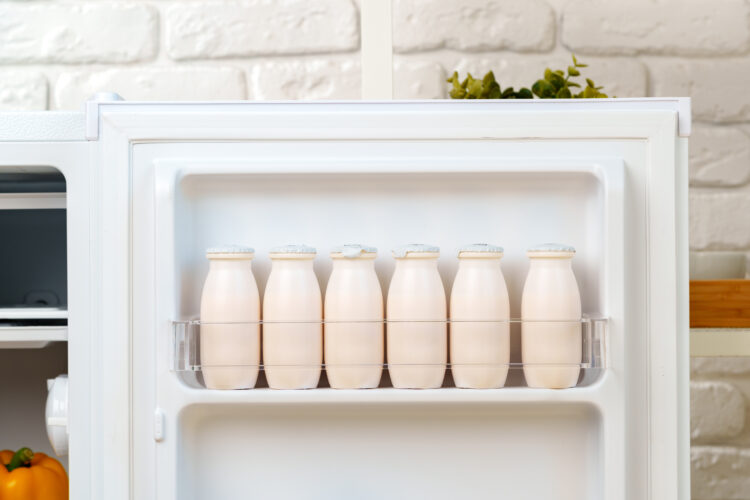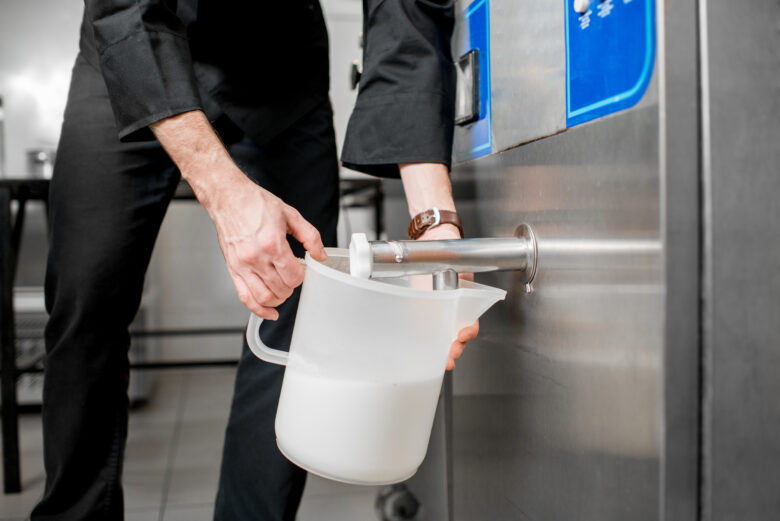Milk pasteurization incorporates many steps, but none of them is as important as the cooling process. Your cows continue grazing as milking machines automatically pump milk into the refrigerated tank, after which it goes for pasteurization. And this is exactly where the milk chiller comes in handy. Pasteurization heats milk. Chillers take heat away from pasteurization and cool milk down to the desired temperature.
Keeping your milk at a cool temperature prevents it from deteriorating. It keeps it fresh and also prolongs its storage life.

Choosing the Right Dairy Chiller
The type of milk chiller you need will solely depend on the size of your operation. Plate chillers are perfect for large productions. They’re designed to use a mixture of glycol and water to cool milk to an appropriate temperature.
Air-Cooled vs. Water-Cooled
Dairy chillers are available in water-cooled and air-cooled varieties. Water-cooled chillers usually transfer heat to a water source and need a mechanical room since they feature special equipment that air-cooled models don’t have. Air-cooled chillers, on the other hand, transfer heat to the surrounding air and require open airy space.
When shopping around for these fixtures, it’s important to contact an expert who’ll help you decide whether you need a water-cooled or an air-cooled design. Though water-cooled chillers are quite expensive, they’ve lower energy costs. Air-cooled chillers are great for use in areas that experience frequent water shortages.
Surface Cooling
For this type of chilling, multiple hollow pipes are welded and then joined at both ends to spearhead the continuous flow of cold water. This structure is then installed on the iron frame and the milk is transported through a faucet to the perforated tray. Thereafter, the chilled milk is collected at the lower side of the pipes through a fixed milk outlet. The water is continuously chilled with the help of an air-cooled condensing unit.
In milk chilling, the cooled water moves through thin pipes. As milk enters through the faucet and flows downwards, its temperature is significantly reduced by the chilled water nearby. This type of cooling is an effective way of cooling milk and making it last longer. There are zero chances of contamination since the structure is easy to clean and maintain.
Plus, it cuts down on costs by reducing the labor required and decreasing energy consumption. The amount of milk handled at a go is also increased, hence improving the number of profits you make. And as an entrepreneur that’s exactly what you need, right?
Cooling System Principles
To determine whether efficiency gains in your cooling system might be achieved, you must understand the different types of systems, their strengths, and their shortcomings. Cooling systems are available in various designs, each with its unique benefits and limitations. Generally speaking, all cooling systems use a combination of several design features to ensure that you get the best results out of your application. The most common cooling system principles are:
Open systems– here, the process medium comes into contact with the environment. They’re widely applicable to wet systems you can also incorporate them into once-through and re-circulated designs. With such a system, it’s possible to achieve optimal efficiency as well as outstanding reliability. Plus, chilled milk will be free of contaminants and a hundred-percent safe for human consumption.
Closed systems – in these systems, the process media flows inside tubes or heat exchanges and doesn’t come into contact with the environment. This ensures that the surrounding remains clean and safe.
Once-through – the coolant passes through a heat exchanger once before it’s returned to its source. Though simple, this cooling technology ensures that you get high-quality milk as well as improved yields. Plus, it’s easy to set up and manage.
Re-circulated – heat is absorbed in the primary exchanger before being transferred to the secondary exchanger. In this cooling technique, the coolant is often reused and environmental impacts are eliminated through water supply.

Direct or Indirect– Direct systems feature one heat exchanger, a process media, as well as a coolant. On the other hand, indirect systems come with at least two heat exchangers, a closed secondary coolant, and a primary coolant. They’re often applied where the leakage of process substances into the environment must be avoided.
Wet or Dry– Dry systems typically utilized forced air over tubing filled with fluid process media and are only applicable to closed systems. In wet cooling, the process fluid is cooled with water in a closed heat exchanger or with air in an open cooling tower.
The type of cooling system you choose might help in reducing or eliminating environmental impacts. Air or water cooling towers can be utilized instead of one-through systems to minimize water usage as well as thermal water pollution. A fin fan chiller could also go a long way in reducing your facility’s water consumption, particularly in dry locations.
Milk Chilling and Its Benefits
Milk is so crucial in today’s food processing industry. Following the high demand for this product, numerous technologies have been developed to increase its quotient of quality. And milk chilling is one of the most important inventions for making the milk suitable for human consumption. It inhibits the growth of microorganisms and protects the milk from contamination. And it’s often carried out with various methods, including Can Cooling, Tubular Cooling, Can Immersion, Surface Cooling, and Plate Chillers.
Depending on your specific needs, there’s always a milk chiller that’ll perfectly meet your demands. Whether you prefer a direct, indirect, water-cooled, or an air-cooled system, you can rest assured that you’ll always get the best quality from a milk chiller.
Final Thoughts
The current food industry is ripe for investment. And milk production is one of the areas you may want to consider venturing into. Advanced technologies have been developed to optimize its production, processing, and preservation. Imagine a situation where your cows continue grazing while milking machines automatically pump milk into cooling units. Milk chillers are efficient, reliable, and highly durable. They’ll definitely minimize downtime and significantly increase profitability.












Leave a Reply